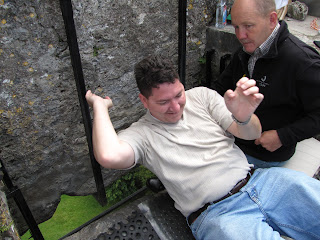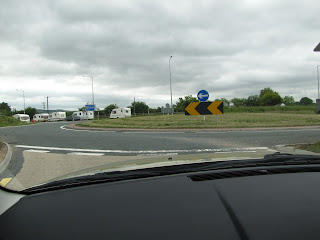
After a much needed rest at our wonderful hotel, we hit the road again, this time to Castle Cahir. This was our favorite castle we visited because we were able to scramble all over the castle. No guard rails (well, just one), no off limits areas. The whole castle was available to us to run around on, ramparts and everything. It was so cool!
 |
| View from the upper walkway. Look ma! No guardrails! |
We were able to run all over this castle and climb like monkeys. The guided tour was fantastic and we learned so very much from the tour guide. We also learned quite a bit about Irish history during this tour. This was our first exposure to General Oliver Cromwell. I vaguely remember him being a blip on our English history radar waaaay back in high school, but neither of us remembered anything substantial about him.
So, here is a brief history of General Cromwell. Just in case you're a history buff like me and haven't had time to peruse your history books recently or go to Ireland where he's a bigger part of history. Cromwell was one of the generals on the side that won the English civil war. He took over the Commonwealth of England after King Charles I was executed. (*Note: he was one of the men who signed the death warrant for King Charles.) He conquered Scotland and Ireland leading to the animosity between those countries and England to this day. Cromwell disbanded the Parliament in 1653, effectively making himself dictator. After he died, he was buried, but his corpse was later dug up, beheaded, and hung in chains.
Cromwell was (and still is) hated in Ireland. That may be why my history slant is negatively inclined toward Cromwell. I heard it straight from the Irish people. Anyway, Cromwell was only the second invader to bring cannons into Ireland. People had never seen cannons before and they did not understand the damage cannons could do to castles and other fortifications.
I say all that to say this, the occupants of Castle Cahir were smart enough to wave the white flag when Cromwell approached. The castle was undamaged and was preserved for posterity, unlike many of the other structures in Ireland. There were no shots fired by Cromwell on this structure, and it has been very well cared for over the centuries.
The castle was easily defensible, as it was located on an island. Two of the rivers have been filled in over the centuries, but two are still flowing. Cannons have been fired on this structure only once, in 1599, by the Earl of Essex. The Earl won that battle after the cannons arrived. There are two cannon balls still embedded in the stone walls from that battle. The cannon balls are the size of soft balls.
You can see one cannonball over my right shoulder near the corner of the building. It looks like a little black spot on the brick wall underneath the ledge. That's a cannon ball. Pretty cool, right?
 |
| The town of Cahir |
 |
| One of the rivers that used to surround the island |
 |
The second of two rivers that used to make the castle an island.
|
Something you would never see in America. The steps were super narrow. Super narrow. Like barely wider than my foot. It was not so bad to go up, but it was much worse coming down. It makes my palms sweat just thinking of doing it again. BUT, the views from the top were amazing. The ledge was about 10 feet off the ground and you could see for miles and miles when you were on top. Pretty good spot for a look out when the castle was in use as a castle.

Hope you enjoyed the history lesson or skipped right over it. More to come!!

 These are photos of the great banquet hall. It was three stories and had decadent touches throughout the hall. Sometimes it was two stories and sometimes it was three, depending on what the occupants wanted during that current renovation. Apparently castles were always undergoing renovation...
These are photos of the great banquet hall. It was three stories and had decadent touches throughout the hall. Sometimes it was two stories and sometimes it was three, depending on what the occupants wanted during that current renovation. Apparently castles were always undergoing renovation...
 Views from the top of Blarney Castle. The photo on the right is part of the formal gardens on the grounds of the Blarney Castle. The photo on the left is a photo of the county from the top of the castle. The 160+ steps to the top of the castle were worth it just for the views!
Views from the top of Blarney Castle. The photo on the right is part of the formal gardens on the grounds of the Blarney Castle. The photo on the left is a photo of the county from the top of the castle. The 160+ steps to the top of the castle were worth it just for the views!















































